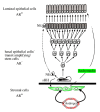Neuroendocrine differentiation in prostate cancer
- PMID: 19956427
- PMCID: PMC2776313
Neuroendocrine differentiation in prostate cancer
Abstract
As any organ in the body human prostate is composed of many different types of cells as well as extracellular components. During prostate development, reciprocal cellular interactions between stromal cells and prostate epithelial cells ultimately lead to the development of a mature prostate. Normal prostate is composed of repeating cellular units that contain stromal and epithelial compartments. The epithelial compartment contains luminal epithelial cells, basal cells and a minor component of neuroendocrine cells whose function may be to regulate the growth, differentiation and secretory function of the prostate gland. Neuroendocrine cells are also evident in prostate cancer and numerous studies showed that its number increases in high grade and high stage tumors, particularly in hormonally treated and hormone-refractory (androgen-independent) prostate cancer. Although androgen withdrawal reduces the secretion of the andromedins from the prostate stromal cells that are critical for the survival for prostate epithelial cells, there is clear evidence that androgen receptor is also required for the tumorigenesis of human prostate cancer, and therefore androgen deprivation therapy likely works through inhibition of androgen receptor in the prostate epithelium. Because neuroendocrine cells lack androgen receptor and are likely androgen-independent, it is conceivable that hormonal therapy for advanced/metastatic prostate cancer, which consists of inhibiting androgen production and/or blocking androgen receptor function, will not eliminate neuroendocrine cancer cells. Instead, these cells may be enriched after the therapy and they may establish paracrine networks to stimulate androgen-independent proliferation of prostate cancer, leading to tumor recurrence. In this article, we will review the known functions of the neuroendocrine cells in prostate cancer, including stimulation of cancer proliferation and invasion, apoptosis resistance and angiogenesis as well as molecular pathways involved in neuroendocrine differentiation.
Keywords: Prostate cancer; hormonal therapy; neuroendocrine.
Figures





Similar articles
-
Function and molecular mechanisms of neuroendocrine cells in prostate cancer.Anal Quant Cytol Histol. 2007 Jun;29(3):128-38. Anal Quant Cytol Histol. 2007. PMID: 17672372 Review.
-
[Neuroendocrine differentiation in prostate adenocarcinoma].Gac Med Mex. 2013 Nov-Dec;149(6):639-45. Gac Med Mex. 2013. PMID: 24276187 Review. Spanish.
-
Differentiation pathways and histogenetic aspects of normal and abnormal prostatic growth: a stem cell model.Prostate. 1996 Feb;28(2):98-106. doi: 10.1002/(SICI)1097-0045(199602)28:2<98::AID-PROS4>3.0.CO;2-J. Prostate. 1996. PMID: 8604398 Review.
-
Neuroendocrine differentiation in prostate carcinoma: focusing on its pathophysiologic mechanisms and pathological features.G Chir. 2010 Nov-Dec;31(11-12):568-74. G Chir. 2010. PMID: 21232206
-
Androgen Receptor Signaling and the Emergence of Lethal Neuroendocrine Prostate Cancer With the Treatment-Induced Suppression of the Androgen Receptor: A Literature Review.Cureus. 2021 Feb 17;13(2):e13402. doi: 10.7759/cureus.13402. Cureus. 2021. PMID: 33754118 Free PMC article. Review.
Cited by
-
Animal models of human prostate cancer: the consensus report of the New York meeting of the Mouse Models of Human Cancers Consortium Prostate Pathology Committee.Cancer Res. 2013 May 1;73(9):2718-36. doi: 10.1158/0008-5472.CAN-12-4213. Epub 2013 Apr 22. Cancer Res. 2013. PMID: 23610450 Free PMC article.
-
Nonblocking Monoclonal Antibody Targeting Soluble MIC Revamps Endogenous Innate and Adaptive Antitumor Responses and Eliminates Primary and Metastatic Tumors.Clin Cancer Res. 2015 Nov 1;21(21):4819-30. doi: 10.1158/1078-0432.CCR-15-0845. Epub 2015 Jun 23. Clin Cancer Res. 2015. PMID: 26106076 Free PMC article.
-
Androgen receptor-dependent and -independent mechanisms driving prostate cancer progression: Opportunities for therapeutic targeting from multiple angles.Oncotarget. 2017 Jan 10;8(2):3724-3745. doi: 10.18632/oncotarget.12554. Oncotarget. 2017. PMID: 27741508 Free PMC article. Review.
-
Expression and functional role of orphan receptor GPR158 in prostate cancer growth and progression.PLoS One. 2015 Feb 18;10(2):e0117758. doi: 10.1371/journal.pone.0117758. eCollection 2015. PLoS One. 2015. PMID: 25693195 Free PMC article.
-
Leukemia Inhibitory Factor Promotes Castration-resistant Prostate Cancer and Neuroendocrine Differentiation by Activated ZBTB46.Clin Cancer Res. 2019 Jul 1;25(13):4128-4140. doi: 10.1158/1078-0432.CCR-18-3239. Epub 2019 Apr 8. Clin Cancer Res. 2019. PMID: 30962287 Free PMC article.
References
-
- Isaacs JT, Coffey DS. Etiology and disease process of benign prostatic hyperplasia. Prostate Suppl. 1989;2:33–50. - PubMed
-
- Bonkhoff H, Stein U, Remberger K. Multidirectional differentiation in the normal, hyperplastic, and neoplastic human prostate: simultaneous demonstration of cell-specific epithelial markers. Hum Pathol. 1994;25:42–46. - PubMed
-
- Bonkhoff H, Remberger K. Differentiation pathways and histogenetic aspects of normal and abnormal prostatic growth: a stem cell model. Prostate. 1996;28:98–106. - PubMed
-
- Qiu Y, Robinson D, Pretlow TG, Kung HJ. Etk/Bmx, a tyrosine kinase with a pleckstrin-homology domain, is an effector of phosphatidylinositol 3′-kinase and is involved in interleukin 6-induced neuroendocrine differentiation of prostate cancer cells. Proc Natl Acad Sci U S A. 1998;95:3644–3649. - PMC - PubMed
-
- van Leenders G, Dijkman H, Hulsbergen-van de Kaa C, Ruiter D, Schalken J. Demonstration of intermediate cells during human prostate epithelial differentiation in situ and in vitro using triple-staining confocal scanning microscopy. Lab Invest. 2000;80:1251–1258. - PubMed
LinkOut - more resources
Full Text Sources
Other Literature Sources
Research Materials
